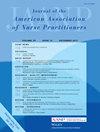The effects of health beliefs and acculturation on the acceptance of human papillomavirus vaccination among Asian Indian parents in the United States.
IF 1.2
4区 医学
Journal of the American Association of Nurse Practitioners
Pub Date : 2024-09-12
DOI:10.1097/jxx.0000000000001068
引用次数: 0
Abstract
BACKGROUND The available limited literature and Centers for Disease Control data suggest that human papillomavirus (HPV) vaccination acceptance is lower among Asian Indians than the general population in the United States. PURPOSE The purpose of the study was to determine the effects of health beliefs, subjective norms, acculturation, and demographics on HPV vaccination acceptance among Asian Indian parents. METHODOLOGY Using a comparative descriptive cross-sectional study design, immigrant and first-generation Asian Indian parents of 9- to 16-year-old children were recruited (N = 171). The survey comprised the Health Belief and Subjective Norms instrument and the Suinn-Lew Asian Self-Identity Acculturation Scale. The analysis included parametric and nonparametric tests. RESULTS Participants who expressed higher levels of perceived barriers were less likely to accept HPV vaccination (odds ratio [OR] = 0.47, p = .016). Spousal opinion negatively correlated with HPV vaccination acceptance (OR = 0.57, p = .006). However, subjective norms positively predicted HPV vaccination acceptance (OR = 1.69, p = .039). Participants who perceived that friends and family approved of the vaccination also had significantly higher rates of vaccination acceptance (OR = 11.99, p = .001). CONCLUSIONS The results revealed unique factors in the acceptance of HPV vaccination in Asian Indians that were not examined or understood before. The applied Health Beliefs and Subjective Norms theoretical framework suggested that perceived barriers, subjective norms, and the opinions of spouses, friends, and family predicted HPV vaccination acceptance. IMPLICATIONS Educational interventions targeting providers, spouses, family, and community members with influential effects on parents may positively affect HPV vaccination acceptance. Providers should note that this population welcomes the provider's recommendations.美国亚裔印第安人父母的健康观念和文化差异对接受人类乳头瘤病毒疫苗接种的影响。
背景现有的有限文献和美国疾病控制中心的数据表明,亚裔印第安人对人类乳头瘤病毒(HPV)疫苗接种的接受程度低于美国一般人群。本研究旨在确定亚裔印第安人父母的健康信念、主观规范、文化适应性和人口统计学对接受 HPV 疫苗接种的影响。方法采用比较描述性横断面研究设计,招募了 9-16 岁儿童的移民和第一代亚裔印第安人父母(N = 171)。调查内容包括健康信念和主观规范工具以及 Suinn-Lew 亚裔自我认同文化适应量表。分析包括参数检验和非参数检验。结果认为障碍水平较高的参与者接受 HPV 疫苗接种的可能性较低(几率比 [OR] = 0.47,p = .016)。配偶的意见与HPV疫苗接种的接受度呈负相关(OR = 0.57,p = .006)。然而,主观规范对接受 HPV 疫苗接种有正向预测作用(OR = 1.69,p = .039)。结论:研究结果揭示了亚裔印度人接受 HPV 疫苗接种的独特因素,而这些因素以前从未被研究或了解过。应用健康信念和主观规范理论框架表明,感知到的障碍、主观规范以及配偶、朋友和家人的意见预测了HPV疫苗接种的接受程度。医疗服务提供者应该注意到,这些人群欢迎医疗服务提供者的建议。
本文章由计算机程序翻译,如有差异,请以英文原文为准。
求助全文
约1分钟内获得全文
求助全文
来源期刊

Journal of the American Association of Nurse Practitioners
Nursing-General Nursing
自引率
16.70%
发文量
172
期刊介绍:
The Journal of the American Association of Nurse Practitioners (JAANP) is a monthly peer-reviewed professional journal that serves as the official publication of the American Association of Nurse Practitioners.
Published since 1989, the JAANP provides a strong clinical focus with articles related to primary, secondary, and tertiary care, nurse practitioner education, health policy, ethics and ethical issues, and health care delivery. The journal publishes original research, integrative/comprehensive reviews, case studies, a variety of topics in clinical practice, and theory-based articles related to patient and professional education. Although the majority of nurse practitioners function in primary care, there is an increasing focus on the provision of care across all types of systems from acute to long-term care settings.
 求助内容:
求助内容: 应助结果提醒方式:
应助结果提醒方式:


